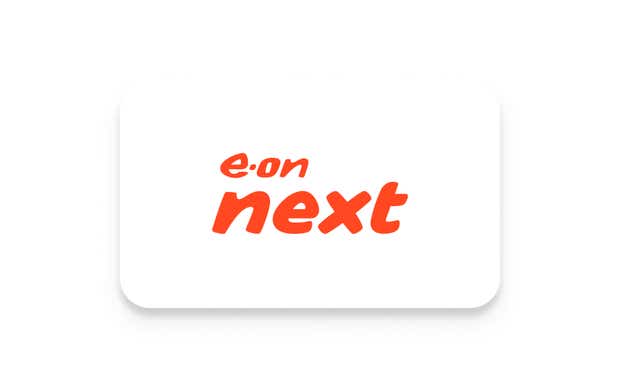E.ON Next tariffs, prices, reviews and other information
E.ON Next is part of the E.ON group, focusing on providing renewable energy to customers across the UK.
Why choose E.ON Next?
E.ON Next is a renewable energy supplier that's part of the E.ON group, so it has the backing of one of the largest energy suppliers operating in the UK. The supplier is a dedicated energy specialist offering 100% renewable electricity as standard, and no exit fees on its energy tariffs.
As a supplier, it’s effectively the same as E.ON, which was one of the original big six energy suppliers in the UK. This rebrand didn’t materially affect customers of E.ON because they simply became E.ON Next customers instead.
Large range of tariffs
Renewable energy provided as standard
A wide range of other products available
Strong customer service record
How do I contact E.ON Next?
E.ON Next can be contacted via:
- Phone: 0808 501 5200 (Monday to Thursday 9am-5pm, Fri 9am-4pm)
- Emergency phone for credit and prepayment issues outside normal working hours: 0808 501 5088
- WhatsApp: 0808 5015 2000
- Email: hi@eonnext.com
What tariffs are offered by E.ON Next?
Fixed energy tariffs
These fix your unit rates and standing charges for the duration of the contract, which usually run anywhere between 12 and 24 months.
Standard variable energy tariffs
E.ON’s SVT is called Next Flex. Its unit rates and standing charges are set according to the price cap, meaning they could go up or down depending on the wholesale market.
Tracker tariffs
These are tariffs designed to change in price depending on wholesale energy prices, but they can go up or down at any time rather than at certain times like SVTs.
EV energy tariffs
E.ON’s EV tariff is called Next Drive. It offers a cheaper electricity rate at night to allow electric vehicle owners with home chargers to charge their vehicles overnight without paying a lot to do so.
Does E.ON Next charge exit fees?
E.ON Next does charge exit fees on its fixed tariffs, in line with other energy suppliers. At the time of writing, these range from £100 to £200, so they’re at the more expensive end of the scale.
Have E.ON Next prices risen in 2025?
To date in 2025, E.ON Next's energy prices have risen once in line with the energy price cap, which increased from £1,717 to £1,738.
Like most energy suppliers in the UK, E.ON Next's energy prices are subject to Ofgem's energy price cap. The cap sets the maximum price suppliers can charge for average usage on their standard variable tariffs. These are typically the most expensive type of energy plan.
Energy wholesale prices increased a great deal from the autumn of 2021 due to a combination of factors, such as supply and generation issues. Since then, prices have been at historical highs, though the price cap has fallen twice since the start of 2024, indicating that the wholesale market is stabilising.
Do I need to do anything about E.ON Next price rises?
All customers on a standard variable tariff from E.ON Next are affected by price rises.
If you're on a fixed plan from E.ON, your rates will stay the same for the remainder of the contract. But remember that you'll automatically be rolled onto a standard variable tariff when your fixed deal ends, which will mean an increase to your energy bills.
You can see fixed energy deals currently available by running an energy comparison below.

Run an energy comparison
Click here to compare energy prices and get started on your energy switch.
E.ON Next 2025 reviews
As of January 2025, E.ON Next’s review score on TrustPilot is 4.5 from over 141,000 reviews. Most of the positive reviews relate to phone conversations with customer service staff (with some outliers who have had opposite experiences). A lot of the more negative reviews relate to meter issues that take a while to resolve.
Can I get a smart meter with E.ON Next?
You can get a free smart meter with E.ON Next if you don’t already have one. You can book your appointment online or call E.ON Next on 0808 501 5266.
What are E.ON Next's other products and services?
E.ON Next’s other products and services include:
- Solar panel installation that can be combined with a Smart Export Guarantee tariff to sell excess electricity back to the grid
- Air source heat pump installation
- Boiler installation and cover
Frequently asked questions
Does E.ON Next offer renewable energy?
E.ON Next fixed tariffs offer 100% sustainable electricity backed by renewable sources. E.ON Next's renewable energy is sourced directly from independent generators across the UK, topped up with renewable energy certificates to guarantee the electricity generated is from a renewable source such as wind, biomass and solar power.
Does E.ON Next have an app?
E.ON Next does have an app available for download from the App Store or Google Play. It can be used to provide meter readings, view and pay bills and top up if you’re on a prepayment meter.
Which providers are similar to E.ON Next?
The other big six energy suppliers are fairly similar to E.ON Next in terms of the number of customers they supply and the breadth of services they offer.
How do I cancel my E.ON Next supply?
If you’re on a standard variable deal with E.ON Next, you can cancel your supply simply by switching to a fixed deal with another supplier. If you’re on a fixed deal with E.ON Next, you can switch but as noted above, exit fees could make it expensive to do so if you’re not in the final 49 days of your contract.
Is E.ON Next going bust?
Given its size, it’s extremely unlikely that E.ON Next is going to go bust. However, the energy market is challenging and unpredictable at the moment and there is a certain level of risk to some suppliers - find out why in our energy market Q&A guide.
Read more




